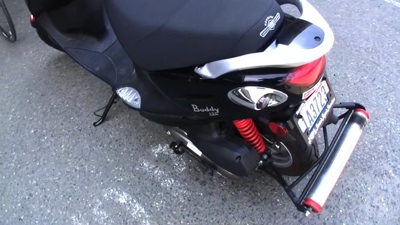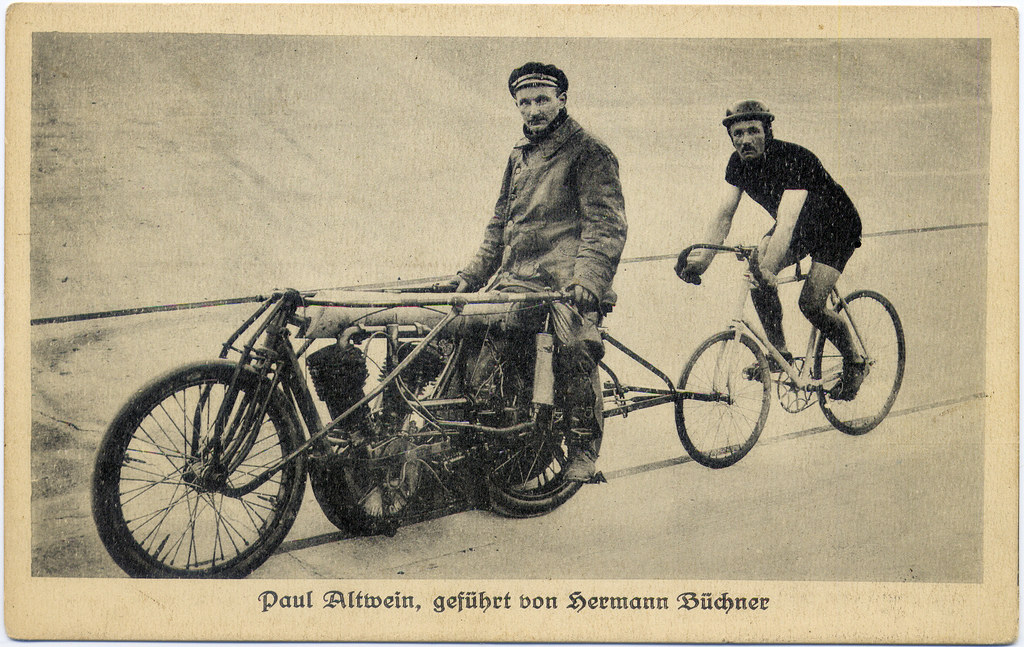I’m slightly reluctant to cover this topic in case someone decides to go out and try this in a rush and ends up the wrong side of local traffic laws or worse, in hospital. So a word of caution first in that this is dangerous and I’m covering what the pros do rather than suggesting you try it for yourself.
Motorpacing is a common technique used by the pros. It has several uses:
- to simulate a race situation where the rider has to hold a wheel
- an extra motivation to encourage the rider to push themselves hard
- to practice riding at high speed where the bike handling is subtly different
- to improve leg speed and comfort on the bike
- for sprinters, to practice coming off a wheel and overtaking
As you probably know, aerodynamics is all important in cycling. If you’ve ever done a group training ride and found yourself able to push yourself that bit harder, well motorpacing session is similar except this time it’s dedicated to you, there’s no need to wait your turn for a pull on the front, the aim of the game is to stay on the wheel of the moto. As such it’s a high speed workout where the scooter is often doing 60-70km/h and you are sat spinning your biggest gear trying to stay in contact. As time goes on it becomes a struggle to hold the rear wheel.
It’s different from using a powermeter. Here the rider doesn’t have to follow the fluctuating LCD display of their SRM or Garmin, instead it’s all about holding the wheel in front, a much more natural instinct. There’s just something more motivating and obvious about trying to hold the wheel instead of sticking to a power target, especially since the high speed involved means that if you lose the wheel you don’t get back on until the moto cuts the throttle. There’s no respite.

It’s common to see the pros using this. Given it is their job it’s common to find a coach or team mate ready to help as the moto rider. Sometimes they might head out for a structured session and other times it’s common to do a four or five ride and then hook up with the moto rider to finish the training with an hour of high intensity work, thus creating a scenario not unlike a major race: hours of high tempo followed by an hour of full gas with high intensity efforts.

Tech
Sometimes it is done behind a car but ideally a motorbike. The choice of machine is important. Generally a small scooter is good although there’s debate about the engine size, some say a small engine is more even compared to the rider, the accelerations are less pronounced; others say a large bike runs smoother and is less prone to slowing on gradients. Either way a scooter is preferable to a motorbike as the more upright position helps and the smaller wheels means the cyclist can get closer into the slipstream.
Safety
This is the big thing. First, there’s the choice of roads. Riders need clear roads where a high speed can be maintained so it’s a question of balancing a small quiet road with one where speed is possible. A check on the weather conditions is important, especially if the wind is gusting.
Next, communication is key. A rider sitting on the wheel of a vehicle at speed is placing a lot of trust in their windbreak. A small move, a touch of the brakes up front and the return journey home will be conducted in an ambulance. Potholes and other problems need to be signalled and some form of communication, via hand-signals or other means is useful.

Another trick is to put a small roller on the back of the scooter. Since a rider is aiming to hold the back wheel, the roller allows a tiny amount of contact, it will spin rather than slowing your front wheel. But it’s nothing amazing, hit it too hard and the rider goes down.
Summary
It’s a useful way to simulate race pace during a training session and it can make for very effective training. Given the logistics and dangers, it’s normally for elite riders only.


I’ve heard the Cancellara model is quite effective…
http://www.youtube.com/watch?v=YOZCXiaaSpU
Incredible riding yet again.
And for those without the luxury of a motorpacer, another trick is to do a couple/few hours with plenty of strong paces and then straight into the evening group ride for that last hour or two. Stay on smaller gears in the paceline and force the adaptation.
For the fearless the buses and trucks can do the job, but IMO the risk is way too high.
Here in Germany I can often pick up a ‘windschatten’ from a ‘junger’ on a ‘mofa’. As the age to drive a Automobile here is 18 many kids have them as they are allowed to drive them from 14. A police enforced governor on the machines means they are officially not allowed to go over 30 kph. Most of them crack that though and some are really flying. My morning ride into the city is always fastest when I can get behind a kid who is also in a hurry. One observation however: Most of the machines are 2 cycle with a mix fuel that really throws up some foul gas. Pros are only following 4 strokes?
Raouligan: the motor will be revving again I suspect.
Starr: yes, a very sensible idea and that works very well.
Zan: I think we’ve all done this at some point… but remember if you can’t see the driver via the mirrors, they can’t see you.
benDE: same in France, kids have restricted machines and two-stroke too. It’s not speed but power and this means many have a consistent power to weight ratio. You can tell the adapted ones by the louder noise and these make for good training. The trouble is that a teenager doesn’t enjoy the fact that his machine is no faster than a cyclist! They are not always the safest wheel but it’s not just teenagers, many have “cyclomoteurs” in France and these are good to draft on the flat and then overtake on a climb.
Inrng : nothing been said about the gas coming out of the exhaust of the moto !
As a cyclist I love training behind a scooter but doing in in Flanders comes with a risk. Most old men use mopeds to rode from town to town and enjoy q drafting rider but they don’t stop smoking their cigars. That can be even more smelly than the two-stroke exhaust. 🙂
Nice! Never seen the roller.
I like getting paced behind my dad’s ex-Police BMW 1300cc moto.
There is a mudflap over the rear wheel that does an excellent job preventing contact.
Finding the right roads to motorpace is a bigger issue
Good read – have never been here before till an athlete I coach forwarded a picture of myself (orange scooter going over pre-pace instructions with FlyV rider). We use a Buddy 125cc – not too powerful but smooth and fast enough for the Pros. The throttle has a good feel that allows the driver to micro-adjust up & down hills + hold it steady on the flats.
This is a good writeup of MP’ing and many athletes have used the scoot as their secret sauce. Per your bullet point number 4, leg speed also is neuromuscular power – pedal fast/hard, coast, pedal hard, coast – over and over, mimicking riding on a wheel under heavy load (power output). MP’ing is also phenomenal time trial training for leg speed at a time trial effort or slightly above.
A pre-pacing safety review is key and thankfully we have never had an incident. We pace Pros and amateurs alike. The safety of the rider is in the hands of the drive and a good driver always knows how to avoid un safe scenarios.
Don’t do as I do and get v.close to a van doing 30 mph. van forgot I was there and pulled over without signalling resulting in a couple of slightly crushed vertebrae and a trip to hospital on a backboard for me. The small Italian Piaggio 3 wheelers are great for drafting behind tho’ or go to a Velodrome derny session and learn the art at 50kph which is what my girlfriend does.
I remember hearing some stories of Cippo going out onto motorways to do some pacing. He’d either get let off or cop the fine as some kind of publicity stunt (Cippo+publicity=tautology!).
From recent twitter posts i understand Cadel Evans’ wife does his and Manual Quinziato’s mum does his in a car.
When I was actively racing (elite amateur), we would do some motor pacing.
The best safest place to do motor pacing is on a velodrome whether you are on a fixed gear bike or a road bike doesn’t matter, as long as you are within the track rules, and other users are aware of what is going on. The advantages are obvious, no traffic, no police, no parked cars, no pedestrians. No hills either, but for most that doesn’t matter. Plus you usually get a very experienced driver, which is the most important thing for safety and training benefit.
When preparing for a trip to race the indoor winter tracks in Germany, we (4 people) even did madison’s behind the motor, and had to sprint past it. Locking onto the roller was great, but being second wheel was so hard!
Vehicle exhaust can be a major problem. Even the vented roofs of the indoor velodrome stadiums don’t help too much during a derny race. Now there are some electric scooters/motos that are amazing.
Re Cipo. It was 2002(?) when he won the World Champs. he was caught by the police slipstreaming behind a Smart car on the autostrada at some 60-70kph. Supposedly the local chief of Police promised to take no action if Mario won the Rainbow jersey. Mario did and another story was born 🙂
You can find a video on YouTube that shows Theo Bos drafting a car at 140km/h. It’s very impressive to see him spinning a 53/11 that fast.
I just use the local traffic at 50km/h to get the last 10km or so home.
Need to get more organised I think…